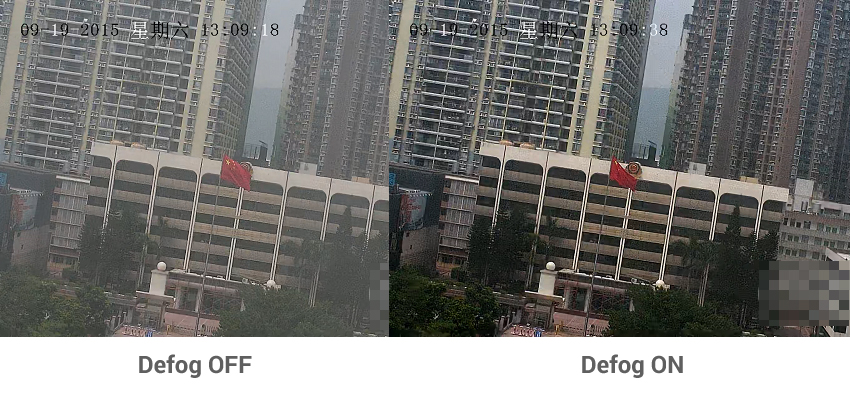
Network camera basic: what's defog technology?
Since surveillance cameras are often installed outside and are expected to stand the test of 24/7 operation, they are frequently exposed to strong light, rain, snow, and fog. These environmental conditions have a great influence on the image quality of the surveillance camera, especially the fog. The aerosol particle containing moisture and fumes in the fog is the main cause for the degrading of the image quality. The low contrast ratio when foggy decreases the image quality so that the details of the scene can’t be seen clearly. Therefore, defog technology is one of the imperative technologies for outdoor surveillance.
At present, one common approach for defogging an image is to use a specific optical component that senses more IR information in fog. One of the liabilities of this physical means is its high cost. Advancements in the development of digital technology brings about the defog image processing technology. This technology adjusts the distribution of the information captured by the image sensor, and enhances the color and details of the surveillance target to decrease the information loss during subsequent processing, such as ISP and encoding compression. In this article, we will go through the digital defog technology.
Classification of digital defog technology
There are two known digital defog algorithms, the non-model image enhancement and the model image recovery method. The non-model image enhancement method increases the contrast ratio to realize the defog function on the basis of the subjective visual judgment. The model image recovery method investigates the reasons why the image quality deteriorates and modularizes the process of the deterioration, and then reverses the process and finally recovers the original image quality.
Non-model image enhancement
The typical ways of non-model image enhancement include the histogram equalization, the filter transformation and the fuzzy logic based theory. The histogram equalization can be divided into the global histogram equalization and the partial histogram equalization. The global histogram equalization has a low computation cost but the enhancement of the detailed information is not sufficient. The partial histogram equalization enhancement has a better effect, but a blocky effect may be caused, and noises are also enhanced.
The filter transformation algorithm provides good image quality, but the computation cost and resource consumption are so high that it is not good for the live view surveillance. The defog effect of the known fuzzy logic based theory is not ideal enough.
All in all, the non-model image enhancement methods can increase the image quality to some extent and the region of interest can be further enhanced to increase the image quality. But in this way, the cause of the image deterioration is never addressed,and it only changes the visual effects and does not enhance the image quality in an effective way.
Model image recovery method
The model image recovery method includes the filtering method, the maximum entropy method and the degraded image function estimation method. The filtering method, such as the Kalman filtering, generally requires heavy computation. The maximum entropy gets a high resolution but it is a non-linear algorithm with huge computation and the calculating process is too complicated. The degraded image function estimation method is normally designed based on a certain physical model, such as the atmospherically scattering model and the polarization property defog model. This algorithm requires the image capture at different times as a reference to determine the parameters of the physical model and since this is a non-real-time method, it is hard to apply for surveillance use.
The complicated surveillance environment and the bad weather demands a requirement of high power consumption, convenience, effectiveness, and adaptability of the surveillance products. Te best practice of the technology must integrate the image enhancement and restoration and be based on the atmospheric transmittance model in order to get a relatively ideal image.
Defog Technology Applications
The digital defog technology can be implemented in a multitude of outdoor surveillance projects, such as the surveillance on highways, railways, seaports, airport runways and other open areas for traffic. The defog function is also important for any perimeter protection or critical infrastructure application. From the application perspective, the defog function is most applicable for outdoor cameras and speed domes to increase the image quality in fog. The back end products like DVRs can’t make the most use of the defog function due to the process of video signal process and data loss that may be caused by the compression algorithms.
Remark: http://oversea-download.hikvision.com/UploadFile/file/Hikvision_Digital_Defog_Technology.pdf
Get My Latest Posts
Subscribe to get the latest updates.
Your email address will never be shared with any 3rd parties.